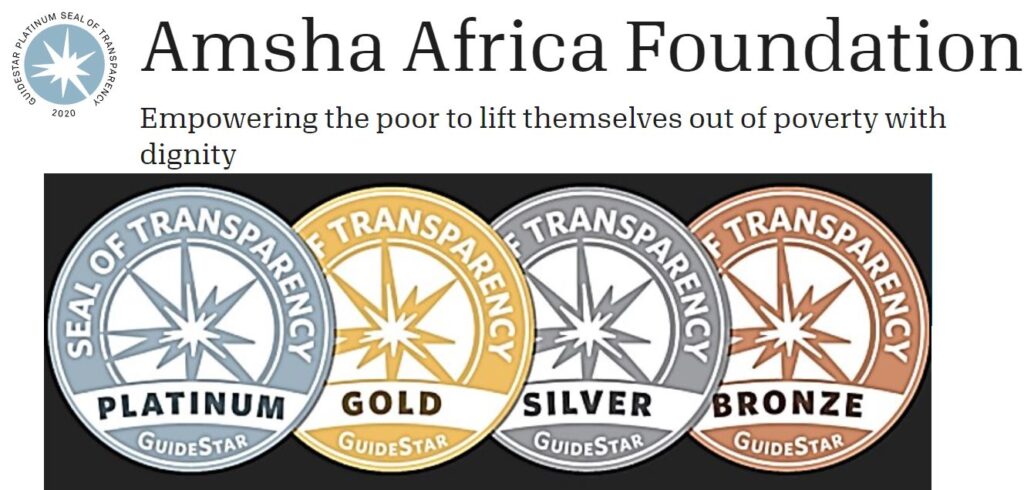Our Financial Records
Amsha Africa Foundation understands that donors consider good financial stewardship to be an essential quality of a charitable organization.
We take every measure to make sure the donated funds, services, or materials go to where they are needed the most and accounted for.
Amsha Africa Foundation has been awarded with “Platinum Seal of Transparency” rating by GuideStar, a 5 star rating by GreatNonprofits organization, and earned a 100% score for the Culture & Community beacon by Charity Navigator.
These ratings come after months of documentation, review and correspondence between AAF. Guidestar. and independent third party reviews posted on Great Non-Profits’ site.
Efficiency
We strive to use every donor dollar efficiently, ensuring that the greatest possible assistance – “program services” – reaches the neediest families and communities in Africa.
Using the most recently audited financials. 92 percent of every AAF dollar goes to program services in Africa. Only 8 percent of every dollar goes to administration (management. general, and fund raising)
Transparency
Amsha Africa Foundation’s fiscal year is July 1 through June 30. For example. FY 2023 was July1, 2022 through June 30, 2023
Financial Accountability
Amsha Africa Foundation’s financial well-being and records are managed by a finance committee that includes two board members, a certified public accountant, and an independent audit firm.
Our book keeping is managed by the non-profit accounting specialists YPTC.
Below are the functions of the finance committee:
- Review the Amsha Africa Foundation’s capital appropriation matters, including recommending approval of those programs requiring board approval and providing periodic oversight of board-approved programs.
- Review the Amsha Africa Foundation’s business plan, cash plan, balance sheet, and capital structure.
- Review Amsha Africa Foundation’s capital allocation strategy, including the cost of capital.
- Consulting with the board on Amsha Africa Foundation’s annual budget process.
- Reviewing and making recommendations on the annual budget.
- Developing and recommend long range financial objectives for Amsha Africa Foundation.
Funds from Donors & Partnerships
Amsha Africa Foundation’s primary source of funds come from individual donor contributions.
Majority of these contributions come from our online websites, sale of our online merchandise, fundraisers, and partnership programs with like-minded organizations such as the Amazon Smile program, E-bay Giving Works program, Google Ad Grant, Benevity, among others.
AAF has also partnered with a charity search page. GoodSearch, where every search by a member benefits us financially.
In addition, AAF receives contributions from charitable members on our social network group in Facebook Twitter, YouTube, and Google among other online networking sites.
We have not received any stipend or grants from any government sources.
Financial Receipts
Amsha Africa Foundation is listed in Guidestar where our non profit reports and financial reports are stored for donors, grantmakers, and businesses to view.Since our inception, we have been filing U.S Internal Revenue Service Form 990-N, also known as the e-Postcard since our annual gross receipts are normally $50,000 or less. These forms can be downloaded from our page within Guidestar.
Note: We stopped posting our financial documents on this website and others due to security issues. To request the most recent audited financial records, please email us at admin@amshaafrica.org
Staff Pay
In an effort to improve efficiency and make sure that every contribution goes to projects that impact the communities we work with, paid staff are mostly field coordinators, messengers, and project managers who are paid during the project phase. Directors and senior staff volunteer their time and expertise because they believe in the charitable cause of the organization.
Salary and allowances for paid staff are funded by personal contributions, fundraisers, donations and sale of our merchandise from our website and social network sites.
Commitments
Amsha Africa Foundation has entered into non-binding memorandums of understanding (MOU) with several strategic partners for the purpose of accomplishing the organization’s goal to support our projects in the global south. These MOU’s document the expected costs of each project, time frames involved, and the desired results.
Revenue Recognition
Donations are recognised at the time the pledge is made. Other revenue is recognized when it is received or when the right to receive payment is established. Grants and subsidies are recognised as income over the period to which they relate.
Classification of Expenses
Expenses are classified functionally as a measure of service efforts and accomplishments. Direct expenses, incurred for a single function, are allocated entirely to that function. Joint expenses applicable to more than one function are allocated on the basis of objectively summarized information or management estimates.
Summary of financial statements
The financial reports have been prepared in accordance with applicable International Accounting Standards.
The financial reports are prepared in accordance with the histoncal cost convention and do not take into account changing monetary values.
The accrual and going concern basis have been adopted. Comparative information is reclassified where approphate to erihance comparability Unless otherwise stated, these accounting:policies are consetent with those of the previous year.
Amounts in the financial report have been rounded off to the nearest dollar
Amsha Africa Foundation’s complete PV 2009 – FY2023 audited financial statements and IRS Form 990s, or those same statements for previous years can be viewed on Guidestar


